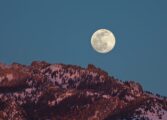By Page H. Gifford
Correspondent
Kathy Nepote, a tree steward with the Charlottesville Area Tree Stewards, talked to Lake Monticello members in June, focusing on the necessity of trees in our environment. The subject has been on the minds of the Lake Monticello Wildlife Committee for a few years, worrying that the disappearing habitats at the Lake being displaced by build-out has had an adverse effect. They have encouraged and educated property owners to help replace what has been lost.
Nepote has been working with Walter Hussey, a Master Naturalist in the county who manages the Pleasant Grove project with other volunteers to ensure habitats will remain for various species. The tree stewards are volunteer members who teach others about planting and maintaining a variety of trees and what works best for the environment.
“Trees are good for oxygen, controlling air pollution by absorbing toxins and controlling water run-off,” said Nepote. “The average decline of species population has been 53 percent and 50 percent of the world’s birds. This is because of the loss of habitat due to urbanization and agricultural intensification. It is ten times worse for insects, such as bees, because of insecticides.”
She showed an example of a property with a house and five acres of rolling lawn which environmentalists call a dead zone. A property next door converted some of their acreage into meadows, creating a stronger habitat for a diverse species.
However, Lake Monticello, similar to other HOAs, has restrictions; there are no tree snags and properties are close and people have concerns regarding precarious-looking or dead trees. To keep tree snags or brush piles at the Lake is a luxury they will not allow. Yet, those who have more acreage in the county can certainly convert some of it into useful habitat.
LM and county residents can help by planting native plants, such as milkweed for caterpillars so Monarch butterflies can flourish. Nepote explained “thinking horizontally with layers of habitat.” Beginning with a tree, it has its canopy and branches, housing birds and mammals, its trunk where others may take up residence, and the forest floor where grubs and other insects revitalize dead leaves and other dead matter into rich soil.
“Non-native trees do not support species like natives do.” There are options for those at the Lake, and those outside, if going too natural is not feasible such as planting fruit trees, and providing food for birds and other mammals. Acorn-bearing trees support chipmunks, squirrels, and bears, and are 75 percent of the diet for deer. Trees, bushes, and undergrowth, with minimal lawns, will prevent water runoff, which is a huge problem at the Lake due to build-out and less landscaping. Riparian buffers near water control erosion, and minimize water run-off and pollution.
“It screens silt, keeping waterways cleaner. They also keep waterways cool, when water gets too hot it deprives aquatic species of oxygen and they will die.” She also discussed dead trees, snags that provide housing for birds and other mammals, and food for insects. It will help to regenerate other trees and bushes. She discussed brush piles, as homes for critters as well.
There are ways to create small habitats at the Lake or larger ones in the county but creating a habitat in which both humans and wildlife can cohabitate is an aim for a better environment.




